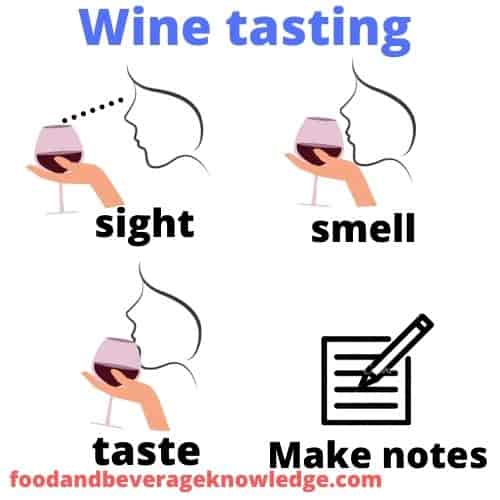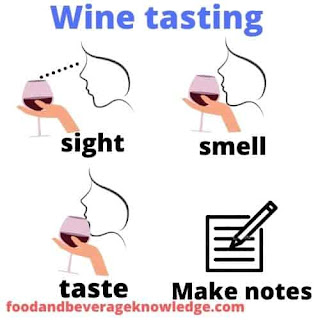Wine tasting is the process of evaluating the wine. It includes the assessment of color. taste, aroma, and finish, it is done by professionals employed by the wineries, wine merchants, sommeliers, and hosts for different reasons in different environments.
- Professionals employed by the wineries: to take corrective measures during aging and blending to ensure the consistency of the product sold.
- Wine merchants: before making purchase decisions
- Sommeliers: in the restaurant before serving the wines to the guests.
- Hosts: before approving the wine for service
Sommeliers are responsible for the service of wine in food and beverage service operations and they should taste the wine for the following reason to
- Ensure the wine is not faulty and it is in acceptable condition
- Describe the wine to the customers
- Understand the nature of complaints given by the host after tasting the wine and know the reasons for them
- Ensure the wine is at the right temperature
Wine tasting is carried out by our senses — Sight, smell, taste, and making notes
It should be understood that each wine has its own characteristics of
- Colour
- Viscosity
- Body
- Aroma and bouquet
- Taste
- Alcohol level
Steps of wine tasting
1. Observe clarity and color(Sight)
Pour 2-3 oz of wine to be evaluated in the wine glass and hold at 45° angle against the white black ground or against the light and observe the color and clarity. Make notes of your observation.
Clarity
The wine should be clear and bright. If it is dull or haze, it shows the sign of faulty fermentation or filtration. The presence of any bubbles in the wine indicates that the wine has started fermenting again in the bottle.
Colour
One can observe the color gently fading between the middle of the wine and the rim of the wine. Some wines have transparent rings, around the rim from which one can assess the flavor. The color of the wine varies according to age.
The color of the white wine ranges from pale straw color to gold. White wine from hot climate and sweet white wine has deep yellow or golden color, and the wine from cold climate has a greenish tinge. white wine with deep amber or brown color may mean a problem
The color of red wine is purple when young and changes to crimson red or reddish-brown when old. Red wine with amber color indicates some problems.
Also Read: Service of wine step-by-step
2. Swirl the glass
Swirl the glass and observe the fall of the wine on the sides of the glass which reveals the viscosity of the wine and take notes.
Viscosity
It refers to the consistency of the wine. When the wine is swirled around the glass, it slides down the glass. When it slides, observe the formation of “lines with beads” which is also called “leg or tears” on the inside of the glass.
The thicker the “leg” the higher the alcoholic content and sugar content. The wine with low alcohol or sugar content will have weak or light “legs”.
3. Swirl and nose the wine (Smell)
Holding the glass by the stem, swirl it gently for 5 seconds. Swirling makes more of the wine come in contact with oxygen and release the alcohol and the elements in the wine that produce the distinctive aroma and bouquet.
Put the nose almost inside the glass and take a quick smell. Compare the smell with any of the fruits, spices, chemicals, vegetables, and flowers and make notes.
4. Swirl and taste the wine (Taste)
Take a small amount of wine, roll it around the mouth, and draw some air through the wine to heighten the flavor, sweetness, dryness, acidity, and astringency of the wine are evaluated. The astringency is associated with red wine which is due to the presence of tannin.
5. Feel the body of the wine
The body is the feel of the wine in the mouth. The body of a wine is contributed by alcohol, sugar, tannin, and acids. Full-bodied wine fills the mouth in a sensuous way. Observe the aftertaste which refers to the feeling in the mouth after tasting.
6. Make notes
Make a note on the observation on the color, clarity, smell, viscosity, taste, body, and aftertaste and sum up your observation, whether the good flavors of the wine last on your palate well after you have swallowed the wine?.
If the wine is nuanced, expressive, textured, and has a long pleasing finish, rest assured you have a winner in your glass: a fine, high-quality wine that deserves to be savored and appreciated for its finesse.
Recommended reading: What are the different types of wine




-min.jpg)
-min.jpg)
-min.jpg)
-min.jpg)